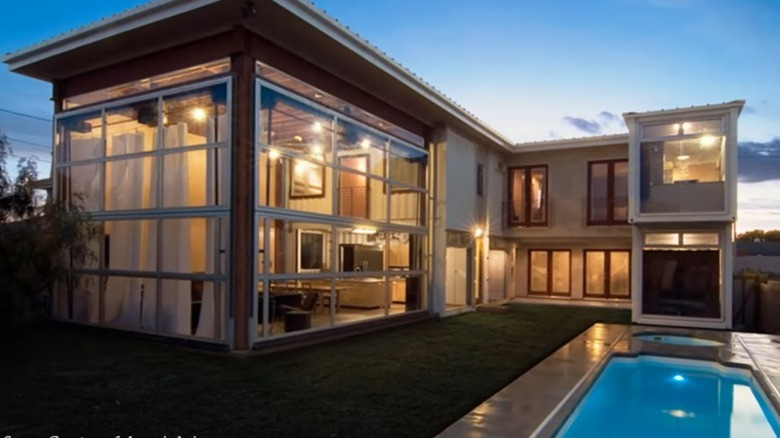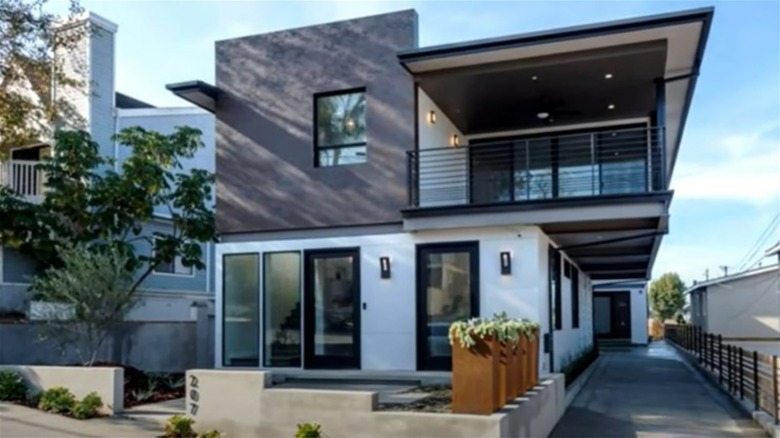Container Homes: What You Need To Know Before You Buy
You might find the 3,200-square-foot home pictured above too modern for your taste, but would you guess that it had been built from eight shipping containers? Architect Peter DeMaria designed and built this house in 2007 in California, according to Container One. Called the Redondo Beach House, it is considered the first U.S.-built shipping container home. The design has a modern aesthetic with aspects of Frank Lloyd Wright's prairie style, and includes four bedrooms and an artist's studio. The 20-foot high main living area has glass-paneled airplane hanger doors on two walls that fold up to create a seamless indoor-outdoor living space. Even the inground pool was made from a shipping container.
DeMaria is one of several architects and builders in the U.S. who have the expertise to convert shipping containers into homes and commercial buildings. Per the DeMaria Design Associates website, the architect's objective is to build well-constructed homes that are affordable, stylish, and environmentally conscious. Building with shipping containers is still a relatively young part of the construction industry, notes Container Home Hub. If you're thinking about this as an option given the housing shortage, here's what you need to know before you buy.
Shipping containers 101
Shipping containers are used like modular building blocks and can be combined with traditional stick-built construction to create a variety of design options. Steel shipping containers come in several different sizes, but the most common are 20-foot, and 40-foot lengths, which are 8-feet wide and 8.5-feet in height, explains Rise Home Design. Taller High Cube containers with a 9.5-foot height are also available, and allow a builder to retain a higher finished ceiling once electrical, insulation, and plumbing have been added (via CW Dwellings).
Construction times for shipping container homes are 25 to 40% less than traditional construction, per PR Newswire. One of the factors contributing to the speed is that the containers can be completely retrofitted in an off-site workshop where builders can add doors, windows, skylights, flooring, and insulation. Since they are very portable, they can then be delivered to a building site ready to be stacked or integrated with stick-frame constructions, notes European Business Review.
Benefits of using shipping containers
The shortage of housing in the U.S. has led to a variety of alternative solutions from charming tiny houses to RV living. Up-cycling shipping containers is another alternative that has a positive impact on the environment, writes Modern Professional, by keeping metal out of landfills. Depending on his clients' requests, Peter DeMaria will use eco-friendly materials to build his sustainable architecture projects, as he did for the 2017 Lucia Container Home pictured above.
Products like bamboo and cork flooring were chosen for their sustainability, and other wood products used are FSC-certified, which means the wood is cut from forests that are responsibly managed. Recycled glass tiles and quartz were used in the bathrooms; and solar panels, reflective paints, and water conservation techniques were used to enhance the house's overall energy efficiency (via Homecrux).
Shipping containers are very strong and structurally sound because they are built to bear heavy loads and survive harsh climate conditions. These containers are also resistant to mold, termites, and fire, explains Granite Transformations. Best of all for homebuyers, container houses are 15 to 30% less expensive to build than traditional construction, as reported by CBS LA (via YouTube).
Potential challenges in building shipping container homes
Pandemic lockdowns, the supply chain crisis, and worker shortages have left some ports around the world without enough containers, while other ports have stacks of containers that either haven't been unloaded and emptied, or are waiting to be shipped back. Hellenic Shipping News warns that these factors have driven up container prices to about $2,300 for the 20-foot size, and about $4,400 for the 40-foot length. While this is expected to eventually ease, it could have a long-lasting impact on both availability and price when it comes to using shipping containers for housing construction.
It's important to use a construction company with experience building with these containers. Just knowing how to select the containers requires extensive knowledge of the subject, says International Port Management Enterprise. Over time, the rough handling of shipping containers can leave older units dented and rusting. However, the management outlet adds that you can also buy containers that have only made a single one-way trip before being sold. Naturally, these will be in much better condition.



